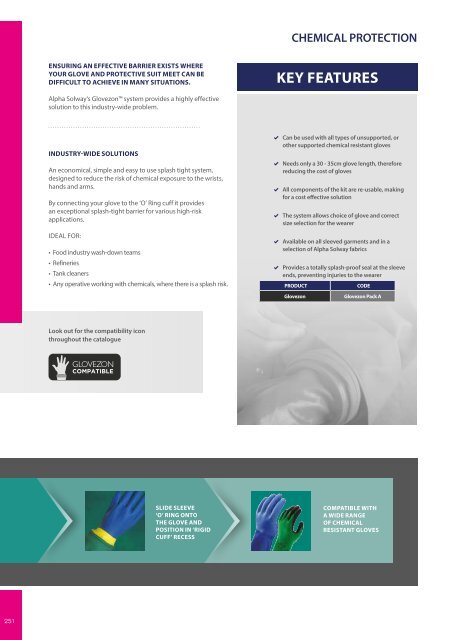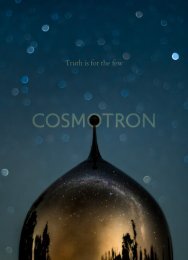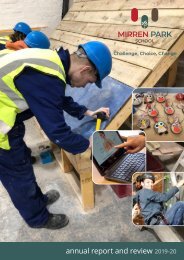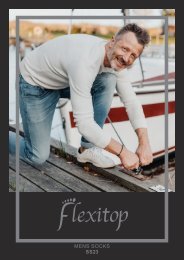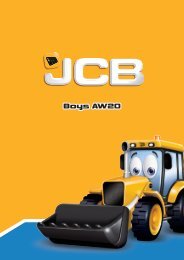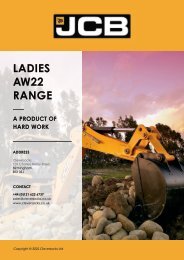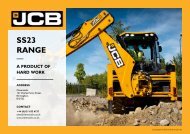LA Safety Catalogue - Issue 6
LA Safety Supplies provide high quality, competitively priced, corporate clothing, workwear, safety boots and shoes, non-safety footwear, janitorial supplies, weather wear, specialist clothing solutions, personal protective equipment, custom embroidery and printing.
LA Safety Supplies provide high quality, competitively priced, corporate clothing, workwear, safety boots and shoes, non-safety footwear, janitorial supplies, weather wear, specialist clothing solutions, personal protective equipment, custom embroidery and printing.
You also want an ePaper? Increase the reach of your titles
YUMPU automatically turns print PDFs into web optimized ePapers that Google loves.
ENSURING AN EFFECTIVE BARRIER EXISTS WHERE<br />
YOUR GLOVE AND PROTECTIVE SUIT MEET CAN BE<br />
DIFFICULT TO ACHIEVE IN MANY SITUATIONS.<br />
Alpha Solway’s Glovezon system provides a highly effective<br />
solution to this industry-wide problem.<br />
INDUSTRY-WIDE SOLUTIONS<br />
An economical, simple and easy to use splash tight system,<br />
designed to reduce the risk of chemical exposure to the wrists,<br />
hands and arms.<br />
By connecting your glove to the ‘O’ Ring cuff it provides<br />
an exceptional splash-tight barrier for various high-risk<br />
applications.<br />
IDEAL FOR:<br />
• Food industry wash-down teams<br />
• Refineries<br />
• Tank cleaners<br />
• Any operative working with chemicals, where there is a splash risk.<br />
CHEMICAL PROTECTION<br />
KEY FEATURES<br />
Can be used with all types of unsupported, or<br />
other supported chemical resistant gloves<br />
Needs only a 30 - 35cm glove length, therefore<br />
reducing the cost of gloves<br />
All components of the kit are re-usable, making<br />
for a cost effective solution<br />
The system allows choice of glove and correct<br />
size selection for the wearer<br />
Available on all sleeved garments and in a<br />
selection of Alpha Solway fabrics<br />
Provides a totally splash-proof seal at the sleeve<br />
ends, preventing injuries to the wearer<br />
PRODUCT<br />
CODE<br />
PPE<br />
IDENTIFYING<br />
HAZARDS<br />
A safety helmet is required in almost every industry<br />
where there is a risk of being injured by falling<br />
objects. In areas of restricted head space where<br />
accidental bumping of the head could be involved<br />
(e.g. overhead piping) a scalp protector (bump<br />
cap) should be considered. Bump caps are not a<br />
substitute for safety helmets and must not be<br />
used to protect the head from falling objects.<br />
IDENTIFYING<br />
MATERIALS<br />
Shells are primarily made using UV<br />
stabilised high density polyethylene<br />
(HDPE) or ABS (Acrylonitrile Butadiene<br />
Styrene). Harnesses are made using<br />
low density polyethylene or Terylene<br />
webbing.<br />
CARE AND<br />
MAINTENANCE<br />
SAFETY HELMET<br />
IDENTITY<br />
STICKER<br />
HAND PPE / HELMETS PROTECTION<br />
Look out for the compatibility icon<br />
throughout the catalogue<br />
COMPATIBLE<br />
SLIDE SLEEVE<br />
‘O’ RING ONTO<br />
THE GLOVE AND<br />
POSITION IN ‘RIGID<br />
CUFF’ RECESS<br />
Glovezon<br />
Glovezon Pack A<br />
COMPATIBLE WITH<br />
A WIDE RANGE<br />
OF CHEMICAL<br />
RESISTANT GLOVES<br />
EUROPEAN<br />
STANDARDS<br />
EN 397 specifies physical and performance<br />
requirements of industrial safety helmets.<br />
Certain tests are mandatory if the product is to<br />
receive EN 397 approval.<br />
These cover:<br />
Shock absorption<br />
Resistance to penetration<br />
Flame resistance<br />
• Chinstrap anchorage<br />
A manufacturer can choose to submit his products to<br />
additional optional tests. Such tests could lead<br />
to one or more of these markings appearing on<br />
a helmet.<br />
-20°/-30°C The helmet will provide some protection<br />
when worn in an environment at or above this<br />
temperature. -40°C ultra low temperature (outside<br />
of EN 397)<br />
440V a.c. The helmet will protect against<br />
short-term, accidental contact with live electrical<br />
conductors up to this voltage<br />
LD The helmet will provide some protection from<br />
lateral compressive loads<br />
MM Molten Metal splash test<br />
EN 50365 Electrically insulating helmets for use on<br />
low voltage installations<br />
EN 812 is the standard for Industrial Bump<br />
Caps, which are intended to provide protection<br />
against bumps caused by walking into hazardous<br />
projections. A Bump Cap does not provide protection<br />
against falling or thrown objects and should not be<br />
used where a safety helmet is required<br />
A helmet may be cleaned with soap and<br />
water, drying with a soft cloth. A helmet<br />
should not be cleaned with abrasive<br />
substances or solvents and must not be<br />
stored in direct sunlight or in contact with<br />
chemicals. The wearer should inspect their<br />
helmet regularly. Any helmet showing more<br />
than superficial abrasions or scuffing to the<br />
shell should be replaced.<br />
SHELF LIFE<br />
To comply with European Standards, all<br />
helmets are marked with the quarter or month<br />
and year of manufacture. If helmets are stored<br />
in boxes in which they were supplied and do not<br />
experience environmental extremes, the shelf life<br />
of a helmet is not limited. However, it is not<br />
recommended that a helmet should be in use<br />
five years after date of manufacture.<br />
SO WHAT ARE THE<br />
DIFFERENCES?<br />
A helmet is not just a helmet. They have many<br />
different features providing specific user benefits,<br />
such as:<br />
• Weight: Some helmets are lighter than others.<br />
A lightweight helmet provides comfort during<br />
prolonged periods of use<br />
• Cradle: A helmet can have either a basic<br />
polyethylene cradle or a more comfortable Terylene<br />
webbing cradle<br />
• Sweatband: A helmet can have either none,<br />
a standard or a high absorbent sweatband for<br />
improved comfort during use<br />
• Ventilation: Some helmets are ventilated,<br />
providing cooling airflow during use<br />
• Badging: Some helmet designs allow for a larger<br />
front badging area, for an enhanced corporate<br />
image<br />
• Peaks: Peak lengths can vary – a reduced peak is<br />
available for improved upward visibility<br />
251<br />
252


